🌿 The WPA’s Fight to Save America’s Lands: Conservation Projects of the 1930s
📌 This 1938 WPA report details how workers planted forests, built irrigation systems, controlled floods, and protected wildlife. Discover how the WPA shaped modern conservation efforts.
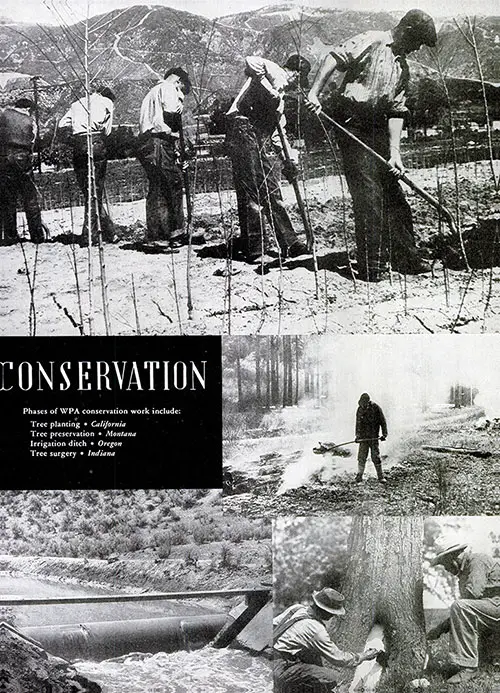
Collage Showing Phases of WPA Conservation Work that Includes Tree Planting (California), Tree Preservation (Montana), Irrigation Ditch (Oregon), Tree Surgery (Indiana). Inventory: An Appraisal of Results of the Works Progress Administration, Washington, DC: US Government Printing Office, 1938. | GGA Image ID # 1520c925ec
🌿 WPA Conservation Projects - 1938
How the WPA Helped Preserve America's Natural Resources and Combat Environmental Crises
📖 The 1938 WPA report on conservation projects reveals a comprehensive effort to protect natural resources, improve environmental conditions, and provide sustainable employment. WPA workers engaged in reforestation, erosion control, flood prevention, irrigation, fish hatcheries, and wildlife conservation—ensuring long-term benefits for future generations.
For teachers, students, genealogists, and historians, this document provides:
✔️ A record of large-scale environmental conservation efforts during the Great Depression.
✔️ Insights into how WPA projects improved flood control, reforestation, and wildlife habitats.
✔️ Details on WPA workers’ contributions to modern conservation practices.
✔️ Examples of government intervention in resource preservation and ecological restoration.
📌 This report showcases the WPA's critical role in mitigating environmental damage and securing natural resources for future generations.
The extensive and varied conservation program of the WPA has provided numerous important links in the drive of many Government agencies to check the destruction of natural resources and repair the ravages of former years. It is a program of long-range benefits.
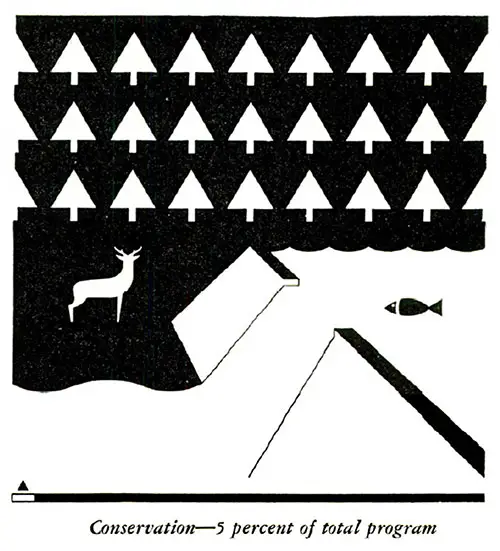
Subject Matter Index Page on WPA Conservation Projects Representing 5 Percent of Total Program. Inventory: An Appraisal of Results of the Works Progress Administration, Washington, DC: US Government Printing Office, 1938. | GGA Image ID # 1521bbe4bd
The front-line battles put up by WPA workers against actual flood and drought will be detailed in another section of the report.
The purpose here is to examine their diverse work designed to anchor the lands which are blowing or washing away, to conserve and control water, to stop forest and prairie fire, and to aid in the propagation of wildlife.
Principally in drought areas, the WPA has built 3,504 new storage dams designed to capture spring freshets and retain them for the parching summer, as well as constructing 17,083 other dams, most of them small, for the dual purpose of better water control and of raising the subsurface water levels.
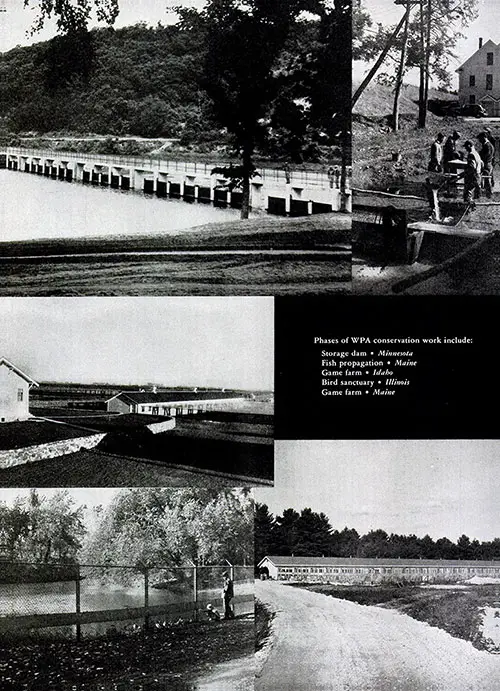
Collage of Other Phases of WPA Conservation Work that Includes Storage Dam (Minnesota), Fish Propagation (Maine), Game Farm (Idaho), Bird Sanctuary (Illinois), Game Farm (Maine). Inventory: An Appraisal of Results of the Works Progress Administration, Washington, DC: US Government Printing Office, 1938. | GGA Image ID # 1520d46582
WPA workers have reforested 32,854 acres by planting 13,453,639 trees. In their work against forest fires they have cleared 1,227 miles of firebreaks, built 32 observation towers and constructed 2,125 miles of fire and forest trails.
Also, by establishing 625 plant and tree nurseries, they have produced and planted an additional 12,559,623 plants and trees. To improve river and stream banks and control floods, they have built over 170 miles of new levees and reconstructed 375 miles more, in the course of which they placed 17,700,000 cubic yards of earth.
They have improved 940 miles of riverbanks and 3,240 miles of stream beds. They have built 10,601 retaining walls, totaling over 400 miles in length, and improved 2,738 others.
They have built 53 miles of canals, exclusive of irrigation canals, 266,935 linear feet of bulkheads, and laid over 4,000,000 square yards of riprap in addition to that on riverbanks.
To aid in the propagation of wildlife, they have established 819 bird and game sanctuaries, and built 139 new fish hatcheries, with a capacity of over 336,000,000 fingerlings each year.
They also have improved or enlarged 81 existing hatcheries. The sealing of 67,327 openings in 7,777 abandoned mines, thus preventing large quantities of acid from polluting American streams, also is a campaign of significance to fishermen.
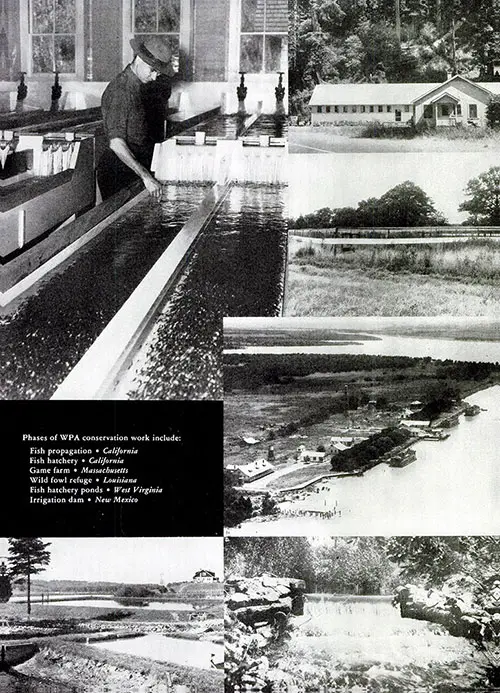
Collage Showing Additional Phases of WPA Conservation Work that Includes Fish Propagation (California), Fish Hatchery (California), Game Farm (Massachusetts), Wild Fowl Refuge (Louisiana), Fish Hatchery Ponds (West Virginia), Irrigation Dam (New Mexico). Inventory: An Appraisal of Results of the Works Progress Administration, Washington, DC: US Government Printing Office, 1938. | GGA Image ID # 152186090e
Experts believe that many streams in the mining areas, from which game fish have been driven, soon may be restocked successfully. The preparation of 59,013 acres of oyster beds, and the planting of 2,633,143 bushels of oysters, has been carried out at the request of local officials whose aim is to rehabilitate professional fishermen by restoring their livelihood.
The WPA has performed a large amount of tree surgery, involving work on over 1,263,984 trees and the removal of 257,000 others which had become diseased.
It also has eradicated noxious plants over an area exceeding 6,300,000 acres and conducted wide campaigns against such insect pests as the Mormon cricket.
In these drives against both insects and weeds, WPA workers have used over 12,000 tons of poison food and 11,700,000 gallons of spray, distributing the latter over an area of 550,000 acres.
For irrigation, 226 miles of flumes or canals have been dug, bringing water to over 120,000 acres, while about ten times as much mileage of existing systems has been rehabilitated, affecting over 1,760,000 acres.
Mostly in the drought area, when water was at a premium, WPA workers dug a total of 1,632 public wells, and reclaimed 1,437 others. In ports and harbors, they have built 99 docks, wharves, or piers, and reconditioned 139 others. They also have constructed 1,161 jetties and breakwaters.
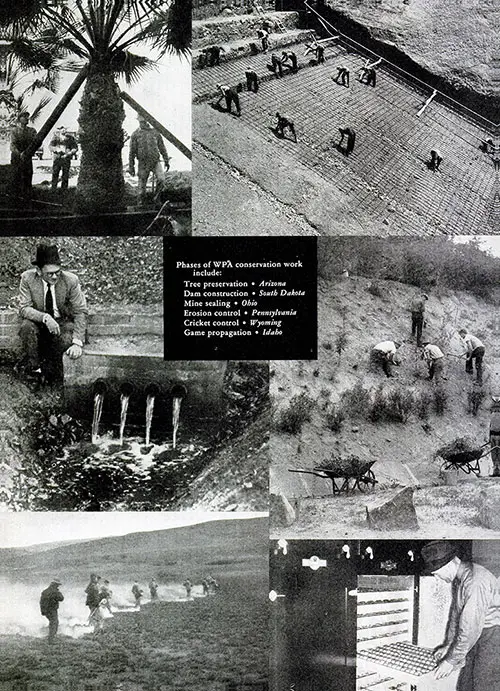
Collage of More Phases of WPA Conservation Work that Includes Tree Preservation (Arizona), Dam Construction (South Dakota), Mine Sealing (Ohio), Erosion Control (Pennsylvania), Cricket Control (Wyoming), Game Propagation (Idaho). Inventory: An Appraisal of Results of the Works Progress Administration, Washington, DC: US Government Printing Office, 1938. | GGA Image ID # 1521ae06dd
"Conservation," in Inventory: An Appraisal of Results of the Works Progress Administration, Washington, DC: US Government Printing Office, 1938, pp. 49-54.
Why This Document is Important
📜 Relevance for Different Audiences
✔ For Historians & Environmentalists
🔹 Documents early conservation efforts and government intervention in resource management.
🔹 Shows how WPA workers fought deforestation, flooding, and soil erosion.
🔹 Connects to modern ecological policies and sustainability initiatives.
✔ For Genealogists & Family Historians
🔹 Ancestors may have worked on WPA conservation projects as tree planters, dam builders, or wildlife preservationists.
🔹 Family members in rural areas may have benefited from WPA irrigation, flood control, or reforestation efforts.
🔹 The document provides a glimpse into local environmental changes during the 1930s.
✔ For Teachers & Students
🔹 Provides a case study on early American conservation policies.
🔹 Illustrates how government work programs shaped modern environmental practices.
🔹 Explores the WPA’s impact on rural communities, farmers, and Native American lands.
📌 This document is a historical blueprint for modern conservation efforts.
::::: Most Engaging & Insightful Content :::::
🌲 Reforestation & Tree Preservation
✔ Why This is Fascinating:
🔹 WPA workers planted 13,453,639 trees to combat deforestation.
🔹 Over 32,854 acres of land were reforested, reducing soil erosion and flooding.
🔹 625 tree nurseries were established to provide seedlings for future planting.
✔ Key Takeaway:
The WPA helped restore forests, prevent soil erosion, and protect watersheds.
📌 This section highlights the WPA’s long-term impact on American forests and agriculture.
💧 Irrigation & Water Conservation
✔ Why This is Fascinating:
🔹 3,504 new storage dams were built to capture water in drought-prone areas.
🔹 17,083 small dams and water retention projects helped raise groundwater levels.
🔹 226 miles of new irrigation canals brought water to over 120,000 acres of farmland.
✔ Key Takeaway:
The WPA secured water supplies for farmers and rural communities during droughts.
📌 This section connects to modern drought prevention and water conservation policies.
🐟 Wildlife Protection & Fish Propagation
✔ Why This is Fascinating:
🔹 819 bird and game sanctuaries were established to preserve wildlife.
🔹 139 new fish hatcheries were built, capable of producing 336,000,000 fish annually.
🔹 2,633,143 bushels of oysters were planted to restore commercial fishing stocks.
✔ Key Takeaway:
The WPA helped repopulate fish and game, benefiting local economies and ecosystems.
📌 This section highlights government intervention in wildlife conservation and sustainable fishing.
🏞 Flood Control, Riverbank Protection & Levees
✔ Why This is Fascinating:
🔹 170 miles of new levees were built, reducing the risk of catastrophic floods.
🔹 375 miles of existing levees were reinforced, improving disaster resilience.
🔹 940 miles of riverbanks and 3,240 miles of stream beds were stabilized.
✔ Key Takeaway:
The WPA protected farmland and urban areas from flooding, reducing economic losses.
📌 This section connects to modern flood prevention and emergency management efforts.
🐛 Pest & Disease Control
✔ Why This is Fascinating:
🔹 6,300,000 acres of noxious weeds were eradicated to prevent crop damage.
🔹 12,000 tons of poison food and 11,700,000 gallons of pesticide spray were used to combat invasive species.
🔹 WPA efforts helped control the Mormon cricket infestation, which threatened Western agriculture.
✔ Key Takeaway:
The WPA played a crucial role in controlling pests and improving agricultural yields.
📌 This section connects to modern integrated pest management and agricultural sustainability.
🖼 Noteworthy Images & Their Significance
🖼 🌲 "Collage Showing Phases of WPA Conservation Work"
🔹 Depicts tree planting, irrigation, and forest preservation.
🔹 Illustrates WPA efforts to prevent deforestation and soil erosion.
🖼 💧 "Collage of Other Phases of WPA Conservation Work"
🔹 Highlights fish hatcheries, game farms, and bird sanctuaries.
🔹 Demonstrates WPA contributions to wildlife conservation.
🖼 🏞 "Collage Showing Additional Phases of WPA Conservation Work"
🔹 Depicts dam construction, mine sealing, and erosion control.
🔹 Shows how WPA projects helped prevent pollution and stabilize landscapes.
📌 These images visually capture the WPA’s massive impact on conservation and sustainability.
Bias & Perspective Considerations
✔ Pro-WPA Narrative:
🔹 The report highlights achievements but does not discuss challenges, such as:
🔹 Were WPA conservation efforts sustained after funding ended?
🔹 How effective were the pest control programs?
🔹 Were all communities equally served?
✔ Limited Discussion of Long-Term Impact
🔹 The document does not explore whether conservation practices continued after WPA funding ended.
✔ Lack of Opposition or Criticism
🔹 Some critics believed WPA projects interfered with private industry or local conservation efforts.
🔹 This perspective is missing from the report.
📌 While this document celebrates WPA conservation successes, further research is needed to assess long-term effects and challenges.
Final Thoughts: Why This Report Matters
"WPA Conservation Projects - 1938" is an essential historical record of how the U.S. government tackled environmental challenges, reforested lands, controlled flooding, and preserved wildlife. Through tree planting, irrigation, fish hatcheries, and pest control, the WPA laid the groundwork for modern conservation and sustainability efforts.
📌 Many of the forests, irrigation systems, and levees created by the WPA are still in use today.
💡 The WPA proves that government-led conservation efforts can have a lasting impact on both the environment and the economy. 🌎🌱💧
